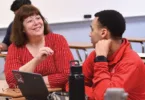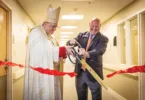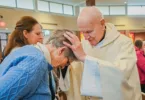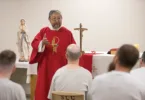
Mike Riley has worked for secular schools. He loves the opportunity to bring faith into the classroom.
by Joe Bollig
joe.bollig@theleaven.org
KANSAS CITY, Kan. — Take a look at a public school classroom and a Catholic school classroom of the same grade. At first glance, you might not see many differences.
Both have the usual things you’d expect in a school: desks and chairs, SMART Boards or whiteboards, colorful art or projects on bulletin boards, textbooks and other instructional resources.
Take a closer look, however, and you’d see that the Catholic school classroom has more “stuff.”
There is a crucifix on the wall, pictures of Jesus and the saints, Bible verses written out on posters or pinned to bulletin boards, Bibles and catechisms, rosaries and other items related to the Catholic faith.
A Catholic education is to be valued not just because of all the “extra stuff” in the classroom, but also the unseen things they represent — faith, values and a Christian worldview.
Catholic education prepares both the mind and the soul for the world and eternity, which is why Catholics all over the nation have been celebrating Catholic Schools Week Jan. 28-Feb. 3.
Many educators and administrators in archdiocesan schools can appreciate what Catholic schools offer because they’ve spent time in both religious and secular schools.
Two of the administrators in archdiocesan schools who’ve spent time in both kinds of schools are Mike Riley, principal of St. Ann School in Prairie Village, and Jessica Rolston, assistant principal of curriculum and instruction at St. James Academy in Lenexa.
Mike Riley
Mike Riley is a native of Baltimore and his wife Ellen is from Topeka. Today, he’s an administrator at St. Ann School in Prairie Village, and Ellen is an art teacher at Resurrection School in Kansas City, Kansas.
They moved from St. Petersburg, Florida, to be closer to Ellen’s side of their family. Mike Riley taught for three years at Bishop Miege High School in Roeland Park, and then at an excellent public high school.
“I loved the experience,” said Riley. “The difficulty was I wasn’t able to talk about how my faith impacts my life. Many students knew I was Catholic without me saying it, through my actions and from [Scripture quotes] behind my desk and a crucifix.”
He experienced culture shock for the first couple of years. He missed being able to lead his class in prayer and to share his Catholic faith.
“[Faith] was key [at Miege in] building classroom community and relationships,” he said.
He decided to return to Catholic education and received an offer to become an administrator at St. Ann School.
“Our kids are faith-filled leaders,” said Riley. “They are joyfully and intentionally looking for ways they can live out their faith and make a difference in our school, our parish and the greater community. Their faith formation is strong, and it began at home.”
Administrators and teachers are promoting a culture in the school that promotes growing in the Catholic faith and achieving academic excellence.
In Catholic schools, the students, staff and administrators can pray freely, go to weekly Mass together and engage in works of charity. And not only do the students have faith formation, but the teachers do as well.
Riley is grateful that he and 10 St. Ann teachers were given the opportunity to go to Israel through the Holy Family School of Faith. It was “life-changing,” he said.
“I love what I do, every day,” said Riley. “We go to the all-school Mass on Friday morning as a community, and that’s part of my workday.”
Jessica Rolston
Jessica Rolston is a veteran educator, spending most of her 17-year career in public schools.
For the past two years, however, she has been the assistant principal of curriculum and instruction at St. James Academy in Lenexa. Her husband Kevin is a physical education teacher in the Kansas City, Kansas, public school system.
Despite many commonalities with public schools, Catholic schools can offer the Christian faith — and that makes all the difference.
The major contrast, she said, is that the Catholic faith is not only “the center of who we are [but] what we are to achieve in our school — to develop a relationship with Jesus Christ and try to get each other to heaven,” said Rolston. “[That’s] our number one goal — with the other things that make a school fall in line.”
At St. James Academy, teachers and students have the opportunity to go to daily Mass; pray alone or with others; talk openly about the Catholic faith; and in terms of witness and instruction, integrate their faith into all parts of the curriculum and put their faith into action.
“On a personal level, I get to have faith formation for myself,” she said. “Not only do we help students in their faith formation, but I get to participate in things such as School of Faith. We can’t help students grow in faith if we don’t grow ourselves. You couldn’t practice your faith in [public] schools.”
The students go on retreats at Prairie Star Ranch in Williamsburg, take theology classes as part of the curriculum, and participate in various activities led by the campus ministry team.
“We just had some students go to the March for Life in Washington, D.C.,” said Rolston. “It was really exciting that they could be a part of something that big.”
“We do a lot of things other schools do as far as learning different things,” she continued, “but we do it through the Catholic worldview and talk about moral issues and how they interact with our faith.
“You can’t have those discussions, necessarily, in a public school classroom.”
A Catholic education is not just about building a good foundation for this life, but to build on that foundation in order to achieve a greater goal.
“We have great public schools surrounding us, but the difference that sets us apart is where our foundation lies,” said Rolston. “It lies in the teachings of Jesus Christ.
“Other schools do service, but our service is directed toward a greater goal — developing a relationship with Christ as we serve others.”
“We hope that when our students leave St. James Academy,” she added, “that they will take that strong foundation of their faith and spread the good news.
“While public schools do a lot of great things, our foundation is where our faith lies, and who we are.”






